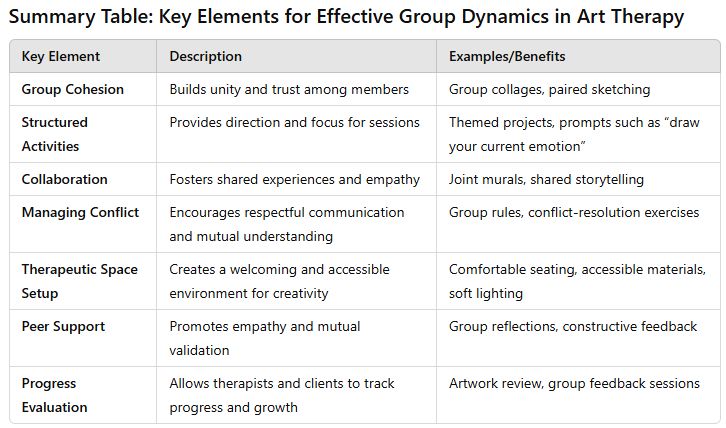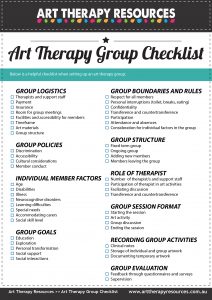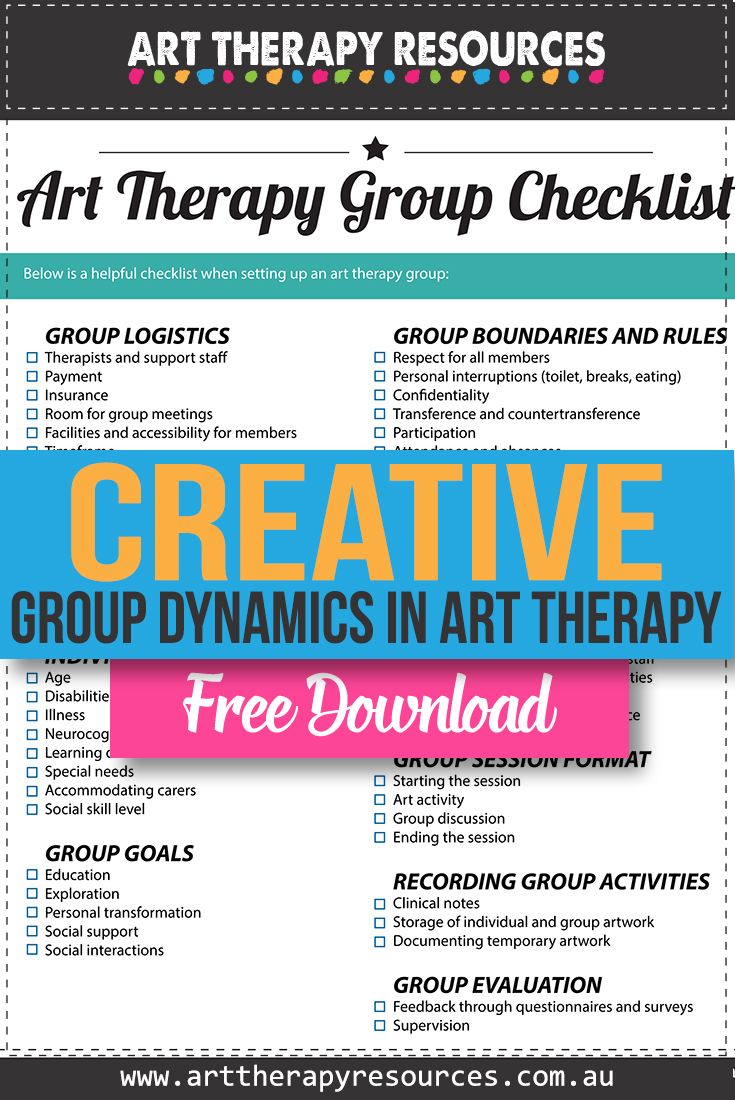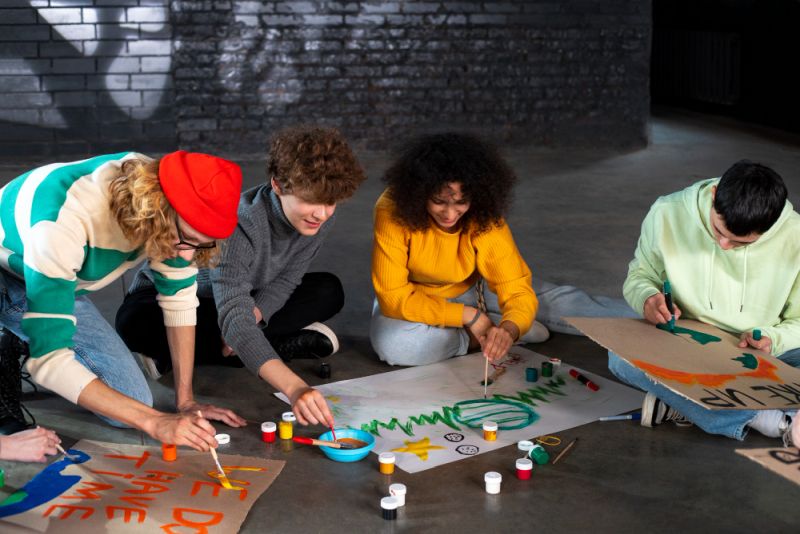THIS POST INCLUDES:
1. Understanding Group Art Therapy
2. Dynamics of Group Art Making
3. Facilitating Group Sessions
4. Free Download Art Therapy Group Checklist
UNDERSTANDING GROUP ART THERAPY
Creative Group Dynamics in Art Therapy
Group therapy in the art therapy field brings a unique array of opportunities and challenges. It allows participants to experience healing within a collective setting, encouraging both individual and communal growth. However, creating and maintaining effective group dynamics in art therapy requires planning and skilled facilitation. It is important to understand the essentials of developing productive and supportive creative group dynamics, emphasizing the importance of cohesion, the role of structured activities, and effective approaches to managing group conflicts.
The Importance of Group Therapy in Art Therapy
Group therapy provides art therapists with an avenue to encourage self-expression and healing within a supportive environment. Unlike individual therapy, group therapy leverages collective interactions, which can enhance self-awareness and empathy. Art-making within a group setting further amplifies these benefits, allowing clients to externalize their experiences and find solidarity through shared creative processes. For therapists, understanding how to create, support, and guide these dynamics effectively is crucial for successful therapeutic outcomes.
Core Principles of Group Art Therapy
In group art therapy, the therapist not only guides individual self-expression but also fosters a sense of community. Core principles include respect, non-judgment, confidentiality, and shared goals. A supportive atmosphere enables clients to take risks in expressing themselves and to reflect on their artwork openly. These core principles serve as the foundation for both creative exploration and interpersonal growth.
Techniques for Building Cohesion in Art Therapy Groups
Creating a cohesive environment in group therapy is essential for a productive and meaningful experience. Ice-breaking exercises and team-building art activities are effective for establishing group cohesion from the outset. Techniques such as collaborative murals or shared art exercises help clients feel connected, as they engage in a shared task with a collective goal. In these activities, each participant contributes a unique piece to a larger project, fostering a sense of inclusion and accomplishment.
Example Cohesion-Building Activities:
– Group Collage: Each participant adds an image or drawing that represents their story, creating a large, interconnected collage.
– Paired Sketching: Clients work in pairs to create mirrored drawings, fostering teamwork and trust.

The Role of Structured Activities in Group Art Therapy
Structured activities provide a framework for art therapy groups, helping participants focus and engage meaningfully. For instance, starting each session with a simple, directed art task can help clients settle in and prepare for deeper exploration. The role of these structured activities is to facilitate expression while giving a sense of direction to the session. Examples include setting specific themes like “draw your current emotion” or “create an image of a safe place,” which can help guide participants’ reflections while promoting open expression.
Encouraging Individual Self-Expression within Group Settings
Though group cohesion is vital, each participant’s individuality must be respected and supported. A group setting does not mean uniformity; rather, each client brings a unique perspective. To honor this, therapists can allow space for personal creation within group exercises. For example, an art prompt like “express how you feel today” allows each member to respond differently while still participating in a communal activity.
DYNAMICS OF GROUP ART MAKING
Benefits of Collaborative Art-Making in Group Therapy
Collaborative art-making in group therapy encourages mutual support and shared learning. When clients work on a single, cohesive project, they build connections by sharing ideas, materials, and space. Through this process, they learn to trust one another and work together toward a common goal, which can alleviate feelings of isolation and increase self-confidence. Additionally, the act of seeing their contributions reflected within a larger piece can help clients feel validated and empowered.
Understanding Emotional Responses to Group Art-Making
Art-making within a group can elicit a variety of emotional responses, from excitement to vulnerability. While some participants may feel inspired by others’ creativity, others might feel exposed or apprehensive about sharing. Therapists need to acknowledge these responses and create a space where clients feel safe to express themselves without fear of judgment. Periodically discussing group members’ feelings about the process can alleviate potential stress and promote honest dialogue.
Managing Group Conflicts and Tensions in Art Therapy
Conflicts are natural within any group setting, including art therapy groups. Art therapy can intensify emotions, and differences in perspective or approach may lead to tension. To address conflicts, art therapists should establish clear guidelines for respectful interaction at the outset of each session. Additionally, therapists can implement conflict-resolution exercises within the group’s art-making process. For example, a joint project where individuals choose colors that represent their feelings and discuss them can open lines of communication and facilitate mutual understanding.
FACILITATING GROUP SESSIONS

Establishing Rules and Boundaries
Setting boundaries is essential for creating a productive and respectful environment in group therapy. Establishing rules at the start, such as respect for others’ work and opinions, confidentiality, and commitment to attendance, helps build a foundation of trust. When boundaries are clear, clients feel more comfortable sharing their thoughts and artwork without fear of judgment. Rules around feedback are also essential to ensure that comments are constructive and compassionate, fostering a non-judgmental atmosphere.
Example Group Rules:
– Respect all group members’ expressions and artwork.
– Share feedback in a supportive manner.
– Maintain confidentiality of group discussions.
Maintaining Flexibility within Structured Sessions
While structure is essential, art therapists should also remain adaptable to the evolving needs of the group. Sessions may require changes in focus or pacing based on group members’ responses. Flexibility allows therapists to pivot when a particular exercise brings up unexpected emotions or insights. For example, if a client’s artwork triggers a meaningful discussion, allowing time for the group to process this experience can foster deeper connection and personal growth.
Fostering Peer Support and Encouragement
Peer support is a powerful dynamic in art therapy groups. Encouraging clients to share thoughts and validate each other’s artwork promotes an atmosphere of empathy and support. Therapists can facilitate group discussions where members are invited to reflect on each other’s work, emphasizing positive reinforcement and active listening. Encouraging members to offer constructive and compassionate feedback can strengthen interpersonal bonds and create a sense of solidarity within the group.
Setting Up a Therapeutic Space Conducive to Creativity
The physical environment plays a critical role in group dynamics. Art therapists should aim to create a space that is comfortable, open, and accessible, with ample lighting and easily accessible materials. A welcoming environment helps reduce anxiety and allows clients to relax and focus on their art. Arranging seating in a circle, for instance, can promote eye contact and inclusivity, fostering a more connected group atmosphere.

Evaluating Group Progress and Outcomes
Regular evaluation of group progress allows therapists to assess the effectiveness of the group and identify areas for improvement. Group feedback sessions can help therapists gain insight into clients’ perspectives on their growth and group experiences. Additionally, reviewing artwork produced over time can provide visual evidence of each member’s personal and interpersonal development. Documenting group progress helps therapists refine their approach and offers clients a tangible representation of their achievements.
Embracing the Potential of Group Therapy in Art Therapy
Group therapy in art therapy holds immense potential for both personal and interpersonal healing. By understanding and cultivating effective creative group dynamics, art therapists can facilitate meaningful interactions and support their clients in their therapeutic goals. Building cohesion, managing conflicts, and fostering a supportive environment enable clients to explore their creativity within a communal setting. These elements collectively contribute to a rich, healing experience that strengthens both individual resilience and group cohesion.

Incorporating these strategies, activities, and approaches helps art therapists facilitate group dynamics that lead to personal insight, creative expression, and interpersonal connection. Group therapy in art therapy presents a distinct opportunity for healing, one that combines individual expression with the power of communal experience.
FREE DOWNLOAD: Art Therapy Group Checklist
SIGN UP below to gain access to our RESOURCE LIBRARY and download the FREE Art Therapy Group Checklist.

BUILD YOUR ART THERAPY REFERENCE MATERIALS:
Pin this image to your Pinterest board.

SHARE KNOWLEDGE & PASS IT ON:
If you’ve enjoyed this post, please share it on Facebook, Twitter, Pinterest. Thank you!


